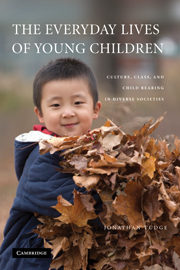Book contents
- Frontmatter
- Contents
- Preface
- Acknowledgments
- 1 Introduction and Stage Setting
- 2 The Daily Lives of Toddlers
- 3 Cultural–Ecological Theory and Its Implications for Research
- 4 Methods
- 5 Life in the Cities
- 6 Everyday Activities
- 7 Settings and Partners
- 8 Everyday Lives
- 9 The Cultural Ecology of Young Children
- References
- Index
- References
- Frontmatter
- Contents
- Preface
- Acknowledgments
- 1 Introduction and Stage Setting
- 2 The Daily Lives of Toddlers
- 3 Cultural–Ecological Theory and Its Implications for Research
- 4 Methods
- 5 Life in the Cities
- 6 Everyday Activities
- 7 Settings and Partners
- 8 Everyday Lives
- 9 The Cultural Ecology of Young Children
- References
- Index
- References
- Type
- Chapter
- Information
- The Everyday Lives of Young ChildrenCulture, Class, and Child Rearing in Diverse Societies, pp. 283 - 302Publisher: Cambridge University PressPrint publication year: 2008

